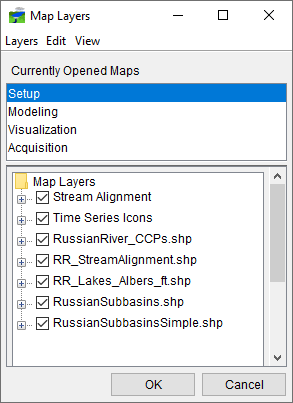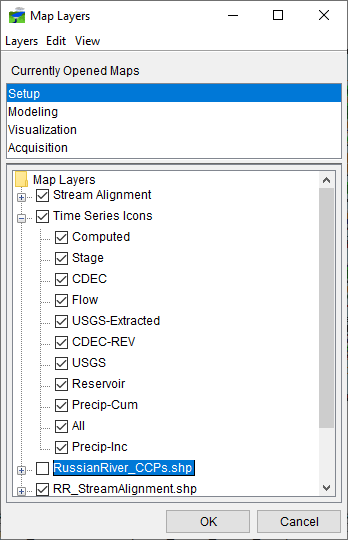Map Layers Dialog
The Map Layers dialog allows the user to add map layers, organize layers, view all the layers associated with the watershed, and add sub-layers to primary layers. The Map Layers dialog can be accessed from any of the modules. From the HEC-RTS main window, from the Maps Menu, click Map Layers. The Map Layers dialog will open. The following sections describe the commands available in the Map Layers dialog.

Menu Bar
The menu bar of the Map Layers dialog contains commands for managing watershed layers. The following is a summary of the available menus and the commands associated with each one.
| Layers | From this menu, you can add map layers; import images; remove map layers; and, close the Map Layers dialog. |
| Edit | From this menu, based on your selection in the Layer Tree (Figure 1), you can rearrange layers, access each layer's properties, and, other items specific to the selected layer. |
| View | This menu has one command, Always On Top, which keeps the Map Layers dialog on top of the HEC-RTS main window. |
Layer Tree
The Map Layers dialog contains a tree (Layer Tree) for controlling the display of layers in a watershed. The Layer Tree represents the hierarchical arrangement of the available layers (primary, map). With the top level of the tree being the Map Layers folder (Figure 1) which contains all layers in the watershed. Beneath the Map Layers folder is a branch for each of the identified layers in a watershed - primary or map layer. To expand a branch, click the plus (+) sign, depending on the layer type you might see sub-layers appear or a legend for the layer appears (Figure 2). When a minus sign (collapses) is displayed, clicking the minus sign collapses the branch. By double-clicking on a layer, the user can expand/collapse the branch and open the selected layer's Properties Editor.
From the Layer Tree (Figure 2), the checkbox turns the display of a layer or sub-layer on or off. If a layer is unchecked, any sub-layers associated with that layer will not display, even if the sub-layers are checked.

Layer Organization
Layers in a Map Window can be organized with the Map Layers dialog. By default, the primary layers are at the top of the layer tree, while map layers are added to the bottom of the layer tree. Typically background images (map layers) are on the bottom, and layers containing smaller, more-detailed items such as time series icons, gages, and rivers are on top. Layers are drawn in the order that they are displayed in the Map Layers dialog. You might want to rearrange the order of layers, because either you cannot view a layer you want to display, or you might need to "hide" a layer.
To rearrange the order of layers:
- From the Map Layers dialog (Figure 2), from the Layer Tree, select the layer that you wish to rearrange. From the Edit menu or by right-clicking on the selected layer, a shortcut menu will display. From either menu, choose Move Up, Move Down, Move to Top (moves the selected layer to the top of the layer tree), or Move to Bottom (moves the selected layer to the bottom of the tree).
- Continue to change the position of the selected layer until the layer is in the desired position. Click OK, and the Map Layers dialog will close.